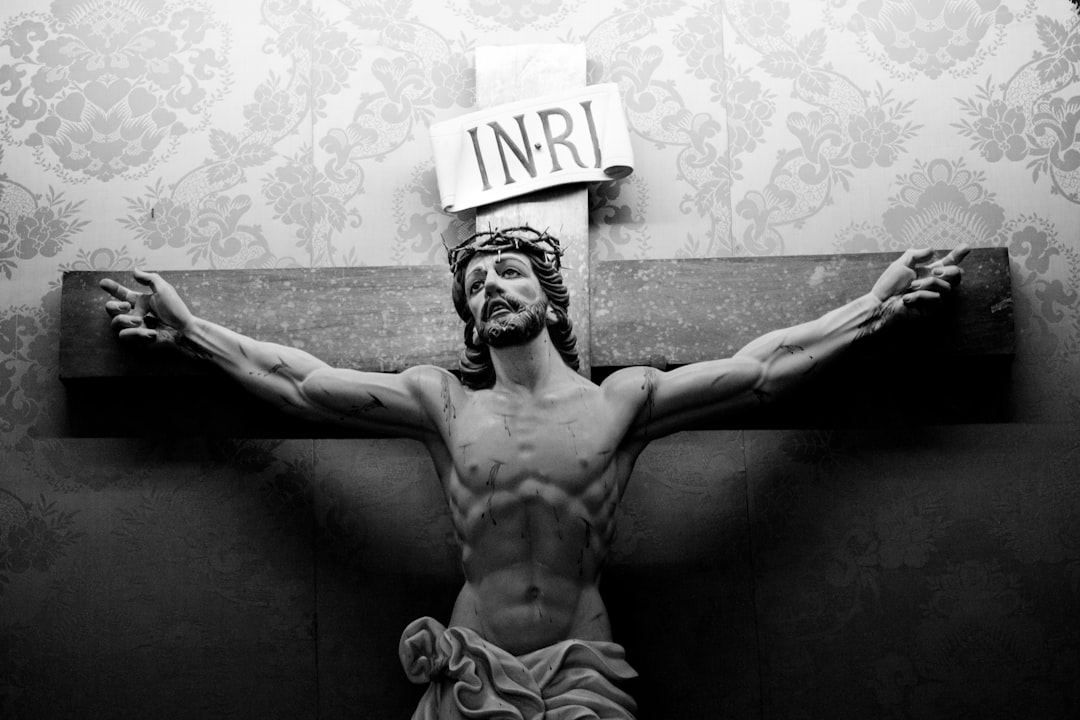The duration of Jesus’ time on the cross has long been a topic of great interest among theologians and history buffs alike. In this comprehensive guide, we’ll delve into the historical and biblical background of crucifixion, explore the sufferings of Jesus on the cross, and examine the significance of his crucifixion in Christianity. Join us as we explore the facts and controversies surrounding Jesus’ crucifixion and uncover its vital importance in the Easter story.
The Historical Background of Crucifixion Practices

Crucifixion is one of the most brutal and painful forms of execution in history. It was commonly used by the Romans and was reserved for slaves, rebels, and those deemed as criminals against the state.
During the Roman Empire, crucifixion was seen as a way to maintain order and control over the population. The punishment was brutal and torturous, and the aim was to inflict as much pain as possible on the victim. It was a slow and agonizing process that often lasted for several days, and the crucified person would ultimately die of suffocation or heart failure.

Crucifixion involved nailing the accused to a wooden cross, usually on a hill or a busy road to serve as a warning to others. The victim would be stripped of their clothes and left exposed to the elements, further adding to their suffering. The hands and feet would be nailed to the cross, and the victim would struggle to breathe as their weight pushed down on their diaphragm, making it increasingly difficult to exhale.
The practice of crucifixion was undoubtedly barbaric, yet it persisted for centuries. Despite its gruesome nature, crucifixion played a significant role in the history of Christianity, particularly in the story of Jesus Christ. According to the biblical account, Jesus was crucified on a Friday, which is now known as Good Friday, and he died on the cross after several hours of suffering.
The use of crucifixion was eventually abolished by Emperor Constantine I in the fourth century, who declared it to be a cruel and inhumane practice. However, its legacy has endured, and the story of Jesus’ crucifixion remains one of the most important narratives in Christianity.
In conclusion, understanding the historical background of crucifixion practices can help us appreciate the immense suffering that Jesus endured on the cross. It also sheds light on the brutality of the Roman Empire and the need for compassion and mercy in our world today.
The Biblical Narrative of Jesus’ Crucifixion
The account of Jesus’ crucifixion is a pivotal moment in Christian belief and has been recounted in the Bible in several gospel accounts. According to historical and religious texts, Jesus was betrayed by his disciple, Judas Iscariot, who handed him over to the Roman authorities, who then put him on trial. He was found guilty of blasphemy and sentenced to be crucified, which was a common Roman practice in punishing criminals during that time in history.
The Gospel of Mark describes the events that led up to Jesus’ crucifixion on Good Friday. He was arrested in the Garden of Gethsemane, near Jerusalem, and taken before the Sanhedrin, a council of Jewish leaders who accused him of blasphemy. He was then taken before Pontius Pilate, the Roman governor of Judea, and accused of trying to overthrow the Roman government.
Pilate then sentenced Jesus to be crucified along with two other criminals. Jesus was then flogged and beaten before being crucified. It was said that he was forced to carry his own cross to the place of his execution, called Golgotha, before being nailed to the cross with iron spikes. Jesus was then left to die on the cross, where he spoke his last words before giving up his spirit and dying.
The Gospel accounts describe some of Jesus’ last words on the cross, including “My God, my God, why have you forsaken me?” and “Father, forgive them, for they know not what they do.” After Jesus died, his body was taken down from the cross and laid in a tomb, where he was buried.
The crucifixion of Jesus has immense religious significance in Christianity, representing the ultimate sacrifice made by Jesus in order to redeem humanity from their sins. It is also seen as a testament to God’s love for humanity and a symbol of forgiveness. The resurrection of Jesus three days after his crucifixion also plays a pivotal role in Christian belief, as it symbolizes the triumph of life over death and the salvation of humanity.

Despite the biblical account of Jesus’ crucifixion, there has been ongoing debate about the historical accuracy of the events described in the Gospels. Some argue that the accounts were exaggerated or manipulated in order to fit with the religious beliefs of early Christians. Others assert that the crucifixion did take place exactly as described in the Bible.
Overall, understanding the biblical narrative of Jesus’ crucifixion is an important aspect of Christian belief and has had a profound impact on Western culture and history. The story of Jesus’ sacrifice on the cross continues to inspire people of faith to this day and is considered one of the most important events in human history.
The Suffering of Jesus on the Cross
The crucifixion of Jesus is one of the most well-known and significant events in Christian history. It is often depicted in artwork, literature, and film as a painful and brutal experience. The pain that Jesus suffered on the cross is difficult to imagine, but understanding it can deepen our appreciation for the sacrifice that he made.
During a crucifixion, the person being crucified was typically nailed to a wooden cross or post and left to hang until they died. The nails would penetrate the wrists and ankles, causing intense pain as the weight of the body pulled against them. In addition to the physical pain, the person being crucified would also experience humiliation and shame as they were displayed in public.
The gospel accounts describe Jesus as being beaten, whipped, and mocked before being crucified. As he hung on the cross, he endured further physical suffering, including thirst, exhaustion, and the struggle to breathe. It is believed that the position of the body made it difficult to breathe properly, causing the person being crucified to slowly suffocate.
In addition to the physical suffering, Jesus also experienced emotional and spiritual anguish. During his time on the cross, he cried out, “My God, my God, why have you forsaken me?” This cry expresses the deep sense of separation that Jesus felt from God as he took on the sins of the world.
« Unpacking the Apostles’ Creed: A Journey Through Christian Doctrines and Beliefs
Why Did Jesus Have to Die? Understanding the Purpose of Sacrificial Redemption »
The suffering that Jesus experienced on the cross lasted for several hours. While the exact length of time is not specified in the gospels, it is believed that he was crucified in the morning and died in the afternoon.
The significance of Jesus’ suffering on the cross is central to Christian theology. It is believed that through his death and resurrection, he made it possible for humanity to be reconciled with God. His sacrifice is seen as the ultimate act of love and grace, as he took on the punishment that we deserved.
While the physical suffering that Jesus endured on the cross is difficult to comprehend, it can serve as a powerful reminder of the depth of God’s love for us. By contemplating the suffering of Christ, we can better appreciate the significance of his sacrifice and the hope that it offers to all who believe.
To summarize:
- During a crucifixion, the person being crucified was nailed to a cross or post and left to hang until they died.
- Jesus endured physical, emotional, and spiritual suffering on the cross.
- This suffering lasted for several hours, from morning until afternoon.
- The significance of Jesus’ suffering is central to Christian theology, serving as a reminder of God’s love and the hope offered through his sacrifice.
The Length of Jesus’ Time on the Cross

The crucifixion of Jesus is one of the most well-known events in human history. It is a story that has been passed down for generations and is at the very heart of the Christian faith. But for those looking to understand the details surrounding the event, how long Jesus was on the cross is a question that often arises.
According to the biblical account of the crucifixion, Jesus was put on the cross around 9:00 in the morning (Mark 15:25). He would have been nailed to the cross at this point and would have been raised up, so that he was hanging in between two other criminals. The gospel accounts all agree that Jesus hung on the cross for three hours before he died.
At noon on the day of the crucifixion, the Bible tells us that darkness fell over the land, remaining until about 3:00 in the afternoon (Matthew 27:45). It was during this time that Jesus suffered and agonized on the cross, in what is believed to be one of the most painful forms of punishment in history.
It is important to note, however, that the duration of the crucifixion was much more than just the three hours that Jesus hung on the cross. The entire process of his arrest, trial, and subsequent crucifixion would have taken place over several hours, if not days.
The religious significance of the crucifixion of Jesus cannot be overstated. For Christians, it represents the ultimate sacrifice made by Jesus to atone for the sins of humankind. It is through the crucifixion that believers are able to find redemption and salvation.

Despite its religious significance, the historical accuracy of the crucifixion accounts has been debated for centuries. Some scholars argue that the gospels are the only reliable accounts that we have of the event, while others believe that the information contained within them has been altered or embellished.
Regardless of the debate surrounding the historical accuracy of the crucifixion accounts, the story remains one of the most important in human history. Understanding the significance of Jesus’ sacrifice on the cross is essential for anyone seeking to truly comprehend the teachings of Christianity.
In summary, Jesus’ time on the cross lasted approximately three hours, according to the Bible. However, the entire process of his arrest and crucifixion would have taken much longer. The crucifixion is an essential story within the Christian faith and understanding its historical significance is important for any student of the religion.
The Significance of Jesus’ Crucifixion in Christianity
The significance of Jesus’ crucifixion in Christianity cannot be overstated. His sacrifice on the cross is considered to be the cornerstone of the Christian faith. Through his death, Christ redeemed humanity and conquered sin and death, making a way for salvation and eternal life. In this section, we’ll explore why Jesus’ crucifixion holds such a special place in Christianity.
-
Redemption and Atonement
Christians believe that Jesus’ death on the cross was a sacrifice that atoned for the sins of humankind. According to Christian doctrine, humankind was separated from God due to sin. But by dying on the cross, Jesus made a way for humanity to be reconciled with God. His death was the ultimate act of love and sacrifice, paving the way for redemption and salvation. -
Forgiveness and Grace
Through his crucifixion, Jesus taught us about the power of forgiveness and grace. Even as he suffered on the cross, he called out, “Father, forgive them, for they do not know what they are doing” (Luke 23:34). This act of forgiveness is considered to be one of the greatest expressions of love and mercy in all of human history. Jesus’ crucifixion illustrates that no matter how great our sins may be, there is always hope for redemption and forgiveness. -
Victory Over Death
Christians see Jesus’ crucifixion as a triumph over death and sin. By dying on the cross, Jesus took the punishment that humanity deserved, and by rising from the dead, he demonstrated his divine power and authority. This victory over death and sin offers Christians hope for eternal life and a future free from suffering and pain. -
Sacrificial Love
The crucifixion of Jesus is the ultimate example of sacrificial love. He willingly offered himself up for the sake of others, even though he knew it would mean great suffering and pain. For Christians, the story of the crucifixion is a powerful reminder of the depth of God’s love for humanity.

In conclusion, Jesus’ crucifixion is at the heart of the Christian faith. His sacrifice and teachings about forgiveness, grace, and sacrificial love have shaped the beliefs and practices of Christians around the world. Understanding and reflecting on the significance of Jesus’ crucifixion can increase one’s appreciation for this most fundamental aspect of Christianity.
The Debate on Historical Accuracy and Interpretation
The crucifixion of Jesus is one of the most significant events in the history of Christianity. However, there has been much debate surrounding the historical accuracy and interpretation of the events surrounding it. Some argue that the Biblical account of Jesus’ crucifixion is accurate, while others believe that it has been embellished or distorted over time.
One area of debate is the timeline of Jesus’ crucifixion. According to the Biblical account, Jesus was crucified at the third hour (Mark 15:25), and died at the ninth hour (Mark 15:34-37). This would suggest a duration of six hours on the cross. However, some historians and theologians argue that the Roman practice of crucifixion typically lasted much longer, sometimes even days. They point to accounts of other crucifixions, such as those during the Roman siege of Jerusalem in 70 AD, where the victims were reportedly left on the cross for days before dying.
Others argue that the events on Good Friday leading up to Jesus’ crucifixion have been embellished or distorted. For example, the Gospel accounts of Jesus’ trial before Pilate and the events leading up to his crucifixion are often portrayed as a clear conflict between Jesus and the Jewish authorities. However, some scholars argue that this conflict may have been exaggerated in the Gospels, in order to blame the Jews for Jesus’ death and further the Christian agenda.
Despite these debates, the crucifixion of Jesus remains a pivotal event in Christian belief. The suffering of Jesus on the cross is seen as a sacrifice for the sins of humanity, and his resurrection after the crucifixion is seen as a symbol of hope and renewed life. Furthermore, the events of that day have become central to the celebration of Easter, the most important holiday in the Christian calendar.

In the end, the debate over historical accuracy and interpretation can add depth and insight into the significance of Jesus’ crucifixion. Regardless of one’s personal beliefs, understanding the historical context behind the event can help to shed light on its religious and cultural significance.
Understanding the Importance of Jesus’ Crucifixion and Resurrection
The crucifixion of Jesus Christ is one of the most significant and controversial events in human history. This event took place in the year AD 30 and is documented in several religious texts, including the Bible’s New Testament. The crucifixion of Jesus was more than just a historical event, it was a spiritual movement that changed the course of history forever.
Jesus’ crucifixion serves as a symbol of hope and redemption for Christians around the world. It reminds us of Jesus’ sacrifice for our sins and his message of love and forgiveness. Christians believe that through Jesus’ sacrifice on the cross, they are redeemed, and their sins are forgiven. This belief is central to the Christian faith and has been passed down through generations of Christians.
The resurrection of Jesus after his crucifixion is equally important to Christians. Jesus’ resurrection is described in the Bible as a miraculous event that occurred three days after his death on the cross. It is a symbol of victory over death and proof that Jesus is the Son of God. Through his resurrection, Christians believe that they too will be resurrected and have eternal life with God in heaven.
The importance of understanding the crucifixion and resurrection of Jesus lies in the message of hope and salvation that they bring to the world. In these events, Christians find meaning and purpose in their lives. They are reminded that there is a loving God who cares for them and wants them to be saved from their sins. They are also reminded of the power of forgiveness and how it can transform their lives and relationships with others.

The debate surrounding the historical accuracy and interpretation of the crucifixion and resurrection of Jesus continues to this day. Some scholars argue that the accounts in the Bible are inaccurate or unreliable. Others argue that the events did not occur at all, or that they were distorted over time.
Despite these debates, however, the significance of Jesus’ crucifixion and resurrection remains a core belief of Christianity. For Christians, it is not just a historical event, but a personal and spiritual experience. It is a reminder of the love and sacrifice of Jesus, and a call to follow his teachings of love, forgiveness, and compassion.
In summary, the crucifixion and resurrection of Jesus Christ serve as a symbol of hope and redemption for Christians around the world. These events remind us of Jesus’ sacrifice for our sins and his message of love and forgiveness. They also provide a deeper understanding of the importance of faith to millions of Christians around the world.












